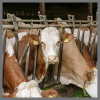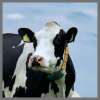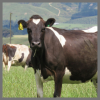-

Jun
05
Interpretive Summary: Heat abatement during the pre-weaning period: effects on the nasal microbiota of Holstein male calves
f8be4390-5c60-47f5-9031-1cd9a24124d2.png?sfvrsn=cc8a5ad1_1)
Strategies to improve housing for pre-weaned dairy calves are gaining attention, especially for reducing the potential impacts of heat stress on their growth and well-being. Researchers have studied how these strategies affect the ability of calves to regulate body temperature, their behavior, and overall performance. The impact of housing on the nasal microbiota, however, remains unexplored.
Read more
-

Jun
05
Interpretive Summary: Developing a regression equation model to predict individual water intake in Holstein growing cattle using reticulorumen temperature
14ac1bfa-48e5-488c-9a65-7f26f266e8d5.png?sfvrsn=ef8a5ad1_1)
Our research looked for a new way of monitoring the water intake of cows which is vital for their health. We used a wireless device called a rumen bolus sensor to monitor the reticulorumen temperatures of cows. We established a regression equation model that could predict how much water a cow drank based on the reticulorumen’s temperature changes.
Read more
-

May
29
Washington Roundup – May 2025

President Trump has made it a top priority to pass a Budget Reconciliation package that addresses tax policy as well as a wide variety of other programs, including some traditionally in the Farm Bill. Republicans in Congress are attempting to complete the process before August recess.
Read more
-

May
29
Artificial Intelligence in Animal Science—A Tool for Learning, Farming, and the Future

Artificial Intelligence (AI) is rapidly transforming many sectors, and animal science is no exception. From classrooms to cattle operations, AI holds promise for enhancing education, improving efficiency, advancing animal welfare, and supporting sustainability in agriculture. However, its successful integration hinges on thoughtful implementation, ethical use, and a willingness to adapt. The following discussion is guided by a recent Animal Frontiers issue volume 14, Issue 6, December 2024 which elegantly reviewed the topic.
Read more
-

May
23
ASAS Foundation Week - Taking Stock - Special Edition - May 23, 2025

ASAS Foundation Week - Taking Stock - Special Edition
May 21, 2025
Read more
-

May
22
Interpretive Summary: Effect of undigestible neutral detergent fiber concentration in finishing diets containing dry-rolled or steam-rolled barley for feedlot steers

Cattle-fed diets with insufficient forage fiber concentrations may be predisposed to various digestive disorders. It has been suggested that there is a minimal fiber requirement for high-grain diets that is influenced by fermentability of the feed, forage particle size, and grain processing.
Read more
-

May
22
Interpretive Summary: Evaluation of indwelling monitoring technologies for measuring reticulorumen pH in cattle

Subacute ruminal acidosis (SARA) is the predominant digestive disorder in feedlot cattle, but the exact timing and ruminal pH parameters associated with SARA are still debated. The need for continuous monitoring of ruminal pH to help define SARA has led to the development of indwelling pH monitoring boli.
Read more
-

May
22
Interpretive Summary: Digestibility of energy and nutrients in soybean expellers produced from conventional or high-oil varieties of soybeans and fed to growing pigs

Recently, a new variety of high-oil soybean patented as PHOTOSEED has been developed, but there are no data for the nutritional value of the de-oiled co-product from this variety. The hypothesis of this experiment was that the digestibility of energy and nutrients in soybean expellers produced from the new variety of high-oil soybeans (SBE-HO) is not different from that of soybean expellers produced from conventional soybeans (SBE-CV).
Read more
-

May
22
Interpretive Summary: Effects of increasing levels of benzoic acid fed to pigs on nitrogen utilization and metabolism affecting growth performance, ammonia emissions, and carcass characteristics

The use of antibiotics as growth promoters has been phased out due to concerns over microbial resistance, creating a demand for alternatives in pig feed. Benzoic acid (BA) has gained attention through its antimicrobial effects in the intestine, potentially improving nitrogen utilization, reducing diarrhea, and ultimately enhancing growth and carcass characteristics in pigs.
Read more
-

May
22
Interpretive Summary: Estrogen promotes autophagy in the mammary epithelial cells of dairy sheep via the CXCL12/CXCR4 axis

Sheep milk is in increasing demand worldwide for its unique nutrients. Mammary physiological processes and lactation performance are regulated by hormones, and studies have shown that estrogen has the ability to regulate autophagy during mammary development, but the specific mechanism is not clear.
Read more
-

May
22
Interpretive Summary: Effects of omega-3 polyunsaturated fatty acid supplementation to first-calf beef heifers during late gestation on offspring physiology and performance

Polyunsaturated fatty acids (PUFA), particularly omega-3 fatty acids, play a crucial role in various body functions related to reproduction, health, and growth in livestock. This study focused on supplementing omega-3 fatty acids to first-calf beef heifers during the last trimester of gestation. The results showed that omega-3 supplementation had a positive impact on immunoglobulin G (IgG) concentration in colostrum and offspring circulation, indicating improved maternal antibody transfer.
Read more
-

May
22
Interpretive Summary: Body reserves dynamics of suckling ewes across successive production cycles under outdoor and indoor contrasting farming system conditions

Body reserves (BR) are vital for ruminants, enabling them to adapt to energy demands during key physiological stages (PhySt) and changing environments. This study assessed how farming systems (FS; indoor vs. outdoor) affect BR dynamics in Romane meat ewes with shared genetics.
Read more
-

May
22
ASAS Foundation Week - Taking Stock - Special Edition - May 22, 2025

ASAS Foundation Week - Taking Stock - Special Edition
May 22, 2025
Read more
-

May
21
ASAS Foundation Week - Taking Stock - Special Edition - May 21, 2025

ASAS Foundation Week - Taking Stock - Special Edition
May 21, 2025
Read more
-

May
20
ASAS Foundation Week - Taking Stock - Special Edition - May 20, 2025

ASAS Foundation Week - Taking Stock - Special Edition
May 20, 2025
Read more
-

May
19
ASAS Foundation Week - Taking Stock - Special Edition - May 19, 2025

ASAS Foundation Week - Taking Stock - Special Edition
May 19, 2025
Read more
-

May
15
Interpretive Summary: Farmers’ attitudes toward animal welfare

Farm animal production has undergone significant transformations in the last 60 years, associated with globalization, population growth, increasing affluence, and the resulting demand for animal products. Altogether, this has driven a significant growth in the global number of animals and continuous changes in the production systems in response to different environmental, social, and economic challenges.
Read more
-

May
15
Interpretive Summary: Welfare perspectives on the management of pregnant, nonlactating dairy cattle during the winter months in pasture-based systems

Pasture-based dairy systems aim to match feed demand with home-grown feed supply by maximizing the amount of pasture in the cows’ diet. This is achieved through concentrated (or ‘compact’) seasonal calving where cows are typically dried off together in autumn and calve in late winter/early spring within a short timeframe (e.g., 78% within 6 wk) so that peak milk production coincides with peak grass growth and by maintaining cows at grass for extended periods (Kelly et al., 2020). While such systems were traditionally seen as extensive, intensification has occurred, leading to discussions about welfare challenges (Mee and Boyle, 2020).
Read more
-

May
15
Interpretive Summary: Heat stress amelioration for pasture-based dairy cattle: challenges and opportunities

Societal scrutiny of animal welfare in food production systems is intensifying. In the dairy sector, the impact of heat stress on cow productivity, health, and welfare is a growing global concern, particularly with increasing temperatures and weather variability predicted to become more extreme (Nguyen et al., 2016). Excessive heat can negatively impact biological functioning including milk production, health, and reproduction (Kadzere et al., 2002), and in severe circumstances, it can cause suffering, reduce quality of life, or even lead to death (Polsky and von Keyserlingk, 2017).
Read more
-

May
15
Interpretive Summary: Welfare implications of poor gilt selection standards in commercial pig production systems

Gilt selection has always been a critical task in the global pig industry. From local breeders within herd book farms to selection specialists within large integrated multisite producers, having a quality selection of incoming great-grand-parent, grand-parent, and parent animals is a core baseline requirement and fundamental for generational success. Key aspects of solid selection have changed over the years, mainly driven by the increased understanding that selection as an outcome of youngstock development achieves desired production results (Patterson and Foxcroft, 2019).
Read more
 JunInterpretive Summary: Heat abatement during the pre-weaning period: effects on the nasal microbiota of Holstein male calves
JunInterpretive Summary: Heat abatement during the pre-weaning period: effects on the nasal microbiota of Holstein male calvesf8be4390-5c60-47f5-9031-1cd9a24124d2.png?sfvrsn=cc8a5ad1_1) Strategies to improve housing for pre-weaned dairy calves are gaining attention, especially for reducing the potential impacts of heat stress on their growth and well-being. Researchers have studied how these strategies affect the ability of calves to regulate body temperature, their behavior, and overall performance. The impact of housing on the nasal microbiota, however, remains unexplored.
Strategies to improve housing for pre-weaned dairy calves are gaining attention, especially for reducing the potential impacts of heat stress on their growth and well-being. Researchers have studied how these strategies affect the ability of calves to regulate body temperature, their behavior, and overall performance. The impact of housing on the nasal microbiota, however, remains unexplored. JunInterpretive Summary: Developing a regression equation model to predict individual water intake in Holstein growing cattle using reticulorumen temperature
JunInterpretive Summary: Developing a regression equation model to predict individual water intake in Holstein growing cattle using reticulorumen temperature14ac1bfa-48e5-488c-9a65-7f26f266e8d5.png?sfvrsn=ef8a5ad1_1) Our research looked for a new way of monitoring the water intake of cows which is vital for their health. We used a wireless device called a rumen bolus sensor to monitor the reticulorumen temperatures of cows. We established a regression equation model that could predict how much water a cow drank based on the reticulorumen’s temperature changes.
Our research looked for a new way of monitoring the water intake of cows which is vital for their health. We used a wireless device called a rumen bolus sensor to monitor the reticulorumen temperatures of cows. We established a regression equation model that could predict how much water a cow drank based on the reticulorumen’s temperature changes. MayWashington Roundup – May 2025
MayWashington Roundup – May 2025 President Trump has made it a top priority to pass a Budget Reconciliation package that addresses tax policy as well as a wide variety of other programs, including some traditionally in the Farm Bill. Republicans in Congress are attempting to complete the process before August recess.
President Trump has made it a top priority to pass a Budget Reconciliation package that addresses tax policy as well as a wide variety of other programs, including some traditionally in the Farm Bill. Republicans in Congress are attempting to complete the process before August recess. MayArtificial Intelligence in Animal Science—A Tool for Learning, Farming, and the Future
MayArtificial Intelligence in Animal Science—A Tool for Learning, Farming, and the Future Artificial Intelligence (AI) is rapidly transforming many sectors, and animal science is no exception. From classrooms to cattle operations, AI holds promise for enhancing education, improving efficiency, advancing animal welfare, and supporting sustainability in agriculture. However, its successful integration hinges on thoughtful implementation, ethical use, and a willingness to adapt. The following discussion is guided by a recent Animal Frontiers issue volume 14, Issue 6, December 2024 which elegantly reviewed the topic.
Artificial Intelligence (AI) is rapidly transforming many sectors, and animal science is no exception. From classrooms to cattle operations, AI holds promise for enhancing education, improving efficiency, advancing animal welfare, and supporting sustainability in agriculture. However, its successful integration hinges on thoughtful implementation, ethical use, and a willingness to adapt. The following discussion is guided by a recent Animal Frontiers issue volume 14, Issue 6, December 2024 which elegantly reviewed the topic. MayASAS Foundation Week - Taking Stock - Special Edition - May 23, 2025
MayASAS Foundation Week - Taking Stock - Special Edition - May 23, 2025 ASAS Foundation Week - Taking Stock - Special Edition
ASAS Foundation Week - Taking Stock - Special Edition MayInterpretive Summary: Effect of undigestible neutral detergent fiber concentration in finishing diets containing dry-rolled or steam-rolled barley for feedlot steers
MayInterpretive Summary: Effect of undigestible neutral detergent fiber concentration in finishing diets containing dry-rolled or steam-rolled barley for feedlot steers Cattle-fed diets with insufficient forage fiber concentrations may be predisposed to various digestive disorders. It has been suggested that there is a minimal fiber requirement for high-grain diets that is influenced by fermentability of the feed, forage particle size, and grain processing.
Cattle-fed diets with insufficient forage fiber concentrations may be predisposed to various digestive disorders. It has been suggested that there is a minimal fiber requirement for high-grain diets that is influenced by fermentability of the feed, forage particle size, and grain processing. MayInterpretive Summary: Evaluation of indwelling monitoring technologies for measuring reticulorumen pH in cattle
MayInterpretive Summary: Evaluation of indwelling monitoring technologies for measuring reticulorumen pH in cattle Subacute ruminal acidosis (SARA) is the predominant digestive disorder in feedlot cattle, but the exact timing and ruminal pH parameters associated with SARA are still debated. The need for continuous monitoring of ruminal pH to help define SARA has led to the development of indwelling pH monitoring boli.
Subacute ruminal acidosis (SARA) is the predominant digestive disorder in feedlot cattle, but the exact timing and ruminal pH parameters associated with SARA are still debated. The need for continuous monitoring of ruminal pH to help define SARA has led to the development of indwelling pH monitoring boli. MayInterpretive Summary: Digestibility of energy and nutrients in soybean expellers produced from conventional or high-oil varieties of soybeans and fed to growing pigs
MayInterpretive Summary: Digestibility of energy and nutrients in soybean expellers produced from conventional or high-oil varieties of soybeans and fed to growing pigs Recently, a new variety of high-oil soybean patented as PHOTOSEED has been developed, but there are no data for the nutritional value of the de-oiled co-product from this variety. The hypothesis of this experiment was that the digestibility of energy and nutrients in soybean expellers produced from the new variety of high-oil soybeans (SBE-HO) is not different from that of soybean expellers produced from conventional soybeans (SBE-CV).
Recently, a new variety of high-oil soybean patented as PHOTOSEED has been developed, but there are no data for the nutritional value of the de-oiled co-product from this variety. The hypothesis of this experiment was that the digestibility of energy and nutrients in soybean expellers produced from the new variety of high-oil soybeans (SBE-HO) is not different from that of soybean expellers produced from conventional soybeans (SBE-CV). MayInterpretive Summary: Effects of increasing levels of benzoic acid fed to pigs on nitrogen utilization and metabolism affecting growth performance, ammonia emissions, and carcass characteristics
MayInterpretive Summary: Effects of increasing levels of benzoic acid fed to pigs on nitrogen utilization and metabolism affecting growth performance, ammonia emissions, and carcass characteristics The use of antibiotics as growth promoters has been phased out due to concerns over microbial resistance, creating a demand for alternatives in pig feed. Benzoic acid (BA) has gained attention through its antimicrobial effects in the intestine, potentially improving nitrogen utilization, reducing diarrhea, and ultimately enhancing growth and carcass characteristics in pigs.
The use of antibiotics as growth promoters has been phased out due to concerns over microbial resistance, creating a demand for alternatives in pig feed. Benzoic acid (BA) has gained attention through its antimicrobial effects in the intestine, potentially improving nitrogen utilization, reducing diarrhea, and ultimately enhancing growth and carcass characteristics in pigs. MayInterpretive Summary: Estrogen promotes autophagy in the mammary epithelial cells of dairy sheep via the CXCL12/CXCR4 axis
MayInterpretive Summary: Estrogen promotes autophagy in the mammary epithelial cells of dairy sheep via the CXCL12/CXCR4 axis Sheep milk is in increasing demand worldwide for its unique nutrients. Mammary physiological processes and lactation performance are regulated by hormones, and studies have shown that estrogen has the ability to regulate autophagy during mammary development, but the specific mechanism is not clear.
Sheep milk is in increasing demand worldwide for its unique nutrients. Mammary physiological processes and lactation performance are regulated by hormones, and studies have shown that estrogen has the ability to regulate autophagy during mammary development, but the specific mechanism is not clear. MayInterpretive Summary: Effects of omega-3 polyunsaturated fatty acid supplementation to first-calf beef heifers during late gestation on offspring physiology and performance
MayInterpretive Summary: Effects of omega-3 polyunsaturated fatty acid supplementation to first-calf beef heifers during late gestation on offspring physiology and performance Polyunsaturated fatty acids (PUFA), particularly omega-3 fatty acids, play a crucial role in various body functions related to reproduction, health, and growth in livestock. This study focused on supplementing omega-3 fatty acids to first-calf beef heifers during the last trimester of gestation. The results showed that omega-3 supplementation had a positive impact on immunoglobulin G (IgG) concentration in colostrum and offspring circulation, indicating improved maternal antibody transfer.
Polyunsaturated fatty acids (PUFA), particularly omega-3 fatty acids, play a crucial role in various body functions related to reproduction, health, and growth in livestock. This study focused on supplementing omega-3 fatty acids to first-calf beef heifers during the last trimester of gestation. The results showed that omega-3 supplementation had a positive impact on immunoglobulin G (IgG) concentration in colostrum and offspring circulation, indicating improved maternal antibody transfer. MayInterpretive Summary: Body reserves dynamics of suckling ewes across successive production cycles under outdoor and indoor contrasting farming system conditions
MayInterpretive Summary: Body reserves dynamics of suckling ewes across successive production cycles under outdoor and indoor contrasting farming system conditions Body reserves (BR) are vital for ruminants, enabling them to adapt to energy demands during key physiological stages (PhySt) and changing environments. This study assessed how farming systems (FS; indoor vs. outdoor) affect BR dynamics in Romane meat ewes with shared genetics.
Body reserves (BR) are vital for ruminants, enabling them to adapt to energy demands during key physiological stages (PhySt) and changing environments. This study assessed how farming systems (FS; indoor vs. outdoor) affect BR dynamics in Romane meat ewes with shared genetics. MayASAS Foundation Week - Taking Stock - Special Edition - May 22, 2025
MayASAS Foundation Week - Taking Stock - Special Edition - May 22, 2025 ASAS Foundation Week - Taking Stock - Special Edition
ASAS Foundation Week - Taking Stock - Special Edition MayASAS Foundation Week - Taking Stock - Special Edition - May 21, 2025
MayASAS Foundation Week - Taking Stock - Special Edition - May 21, 2025 ASAS Foundation Week - Taking Stock - Special Edition
ASAS Foundation Week - Taking Stock - Special Edition MayASAS Foundation Week - Taking Stock - Special Edition - May 20, 2025
MayASAS Foundation Week - Taking Stock - Special Edition - May 20, 2025 ASAS Foundation Week - Taking Stock - Special Edition
ASAS Foundation Week - Taking Stock - Special Edition MayASAS Foundation Week - Taking Stock - Special Edition - May 19, 2025
MayASAS Foundation Week - Taking Stock - Special Edition - May 19, 2025 ASAS Foundation Week - Taking Stock - Special Edition
ASAS Foundation Week - Taking Stock - Special Edition MayInterpretive Summary: Farmers’ attitudes toward animal welfare
MayInterpretive Summary: Farmers’ attitudes toward animal welfare Farm animal production has undergone significant transformations in the last 60 years, associated with globalization, population growth, increasing affluence, and the resulting demand for animal products. Altogether, this has driven a significant growth in the global number of animals and continuous changes in the production systems in response to different environmental, social, and economic challenges.
Farm animal production has undergone significant transformations in the last 60 years, associated with globalization, population growth, increasing affluence, and the resulting demand for animal products. Altogether, this has driven a significant growth in the global number of animals and continuous changes in the production systems in response to different environmental, social, and economic challenges. MayInterpretive Summary: Welfare perspectives on the management of pregnant, nonlactating dairy cattle during the winter months in pasture-based systems
MayInterpretive Summary: Welfare perspectives on the management of pregnant, nonlactating dairy cattle during the winter months in pasture-based systems Pasture-based dairy systems aim to match feed demand with home-grown feed supply by maximizing the amount of pasture in the cows’ diet. This is achieved through concentrated (or ‘compact’) seasonal calving where cows are typically dried off together in autumn and calve in late winter/early spring within a short timeframe (e.g., 78% within 6 wk) so that peak milk production coincides with peak grass growth and by maintaining cows at grass for extended periods (Kelly et al., 2020). While such systems were traditionally seen as extensive, intensification has occurred, leading to discussions about welfare challenges (Mee and Boyle, 2020).
Pasture-based dairy systems aim to match feed demand with home-grown feed supply by maximizing the amount of pasture in the cows’ diet. This is achieved through concentrated (or ‘compact’) seasonal calving where cows are typically dried off together in autumn and calve in late winter/early spring within a short timeframe (e.g., 78% within 6 wk) so that peak milk production coincides with peak grass growth and by maintaining cows at grass for extended periods (Kelly et al., 2020). While such systems were traditionally seen as extensive, intensification has occurred, leading to discussions about welfare challenges (Mee and Boyle, 2020). MayInterpretive Summary: Heat stress amelioration for pasture-based dairy cattle: challenges and opportunities
MayInterpretive Summary: Heat stress amelioration for pasture-based dairy cattle: challenges and opportunities Societal scrutiny of animal welfare in food production systems is intensifying. In the dairy sector, the impact of heat stress on cow productivity, health, and welfare is a growing global concern, particularly with increasing temperatures and weather variability predicted to become more extreme (Nguyen et al., 2016). Excessive heat can negatively impact biological functioning including milk production, health, and reproduction (Kadzere et al., 2002), and in severe circumstances, it can cause suffering, reduce quality of life, or even lead to death (Polsky and von Keyserlingk, 2017).
Societal scrutiny of animal welfare in food production systems is intensifying. In the dairy sector, the impact of heat stress on cow productivity, health, and welfare is a growing global concern, particularly with increasing temperatures and weather variability predicted to become more extreme (Nguyen et al., 2016). Excessive heat can negatively impact biological functioning including milk production, health, and reproduction (Kadzere et al., 2002), and in severe circumstances, it can cause suffering, reduce quality of life, or even lead to death (Polsky and von Keyserlingk, 2017). MayInterpretive Summary: Welfare implications of poor gilt selection standards in commercial pig production systems
MayInterpretive Summary: Welfare implications of poor gilt selection standards in commercial pig production systems Gilt selection has always been a critical task in the global pig industry. From local breeders within herd book farms to selection specialists within large integrated multisite producers, having a quality selection of incoming great-grand-parent, grand-parent, and parent animals is a core baseline requirement and fundamental for generational success. Key aspects of solid selection have changed over the years, mainly driven by the increased understanding that selection as an outcome of youngstock development achieves desired production results (Patterson and Foxcroft, 2019).
Gilt selection has always been a critical task in the global pig industry. From local breeders within herd book farms to selection specialists within large integrated multisite producers, having a quality selection of incoming great-grand-parent, grand-parent, and parent animals is a core baseline requirement and fundamental for generational success. Key aspects of solid selection have changed over the years, mainly driven by the increased understanding that selection as an outcome of youngstock development achieves desired production results (Patterson and Foxcroft, 2019).



